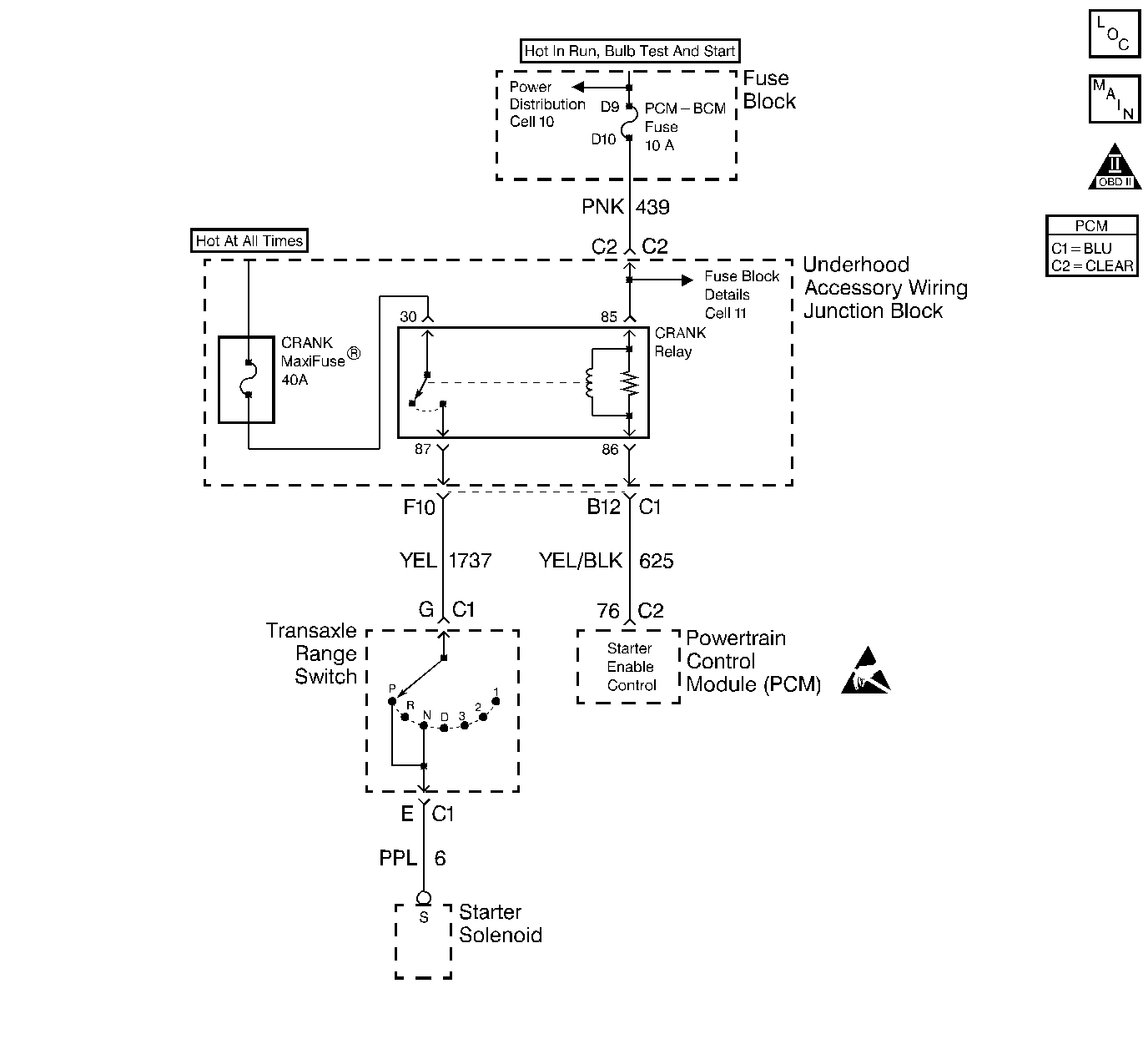
Circuit Description
The Vehicle Theft Deterrent System (VTD) is incorporated within the Body Control Module (BCM). The PCM has the ability to disable starter operation if conditions inappropriate for starter operation exist. The PCM disables the starter if the engine is running, if a correct VTD password is not received from the BCM or if the vehicle operator attempts to engage the starter for an extended period of time.
The PCM controlled starter system consists of the following components:
| • | Starter enable relay. |
| • | The Transaxle Range / Park Neutral Position switch. |
| • | The ignition switch. |
| • | The starter solenoid. |
| • | The PCM. |
Diagnostic Aids
The PCM Controlled Starter Diagnosis table is intended to identify electrical malfunctions that can occur with the system. For additional system diagnosis, refer to Starter and Charging in Electrical Diagnosis. For starter motor diagnosis and on-vehicle service, refer to Cranking System .
Check for the following conditiofsns:
| • | Poor connection at the PCM , the starter enable relay, the Transaxle Range / PNP switch, the ignition switch or the starter solenoid. |
| Inspect harness connectors for the following conditions: |
| - | Backed out terminals. |
| - | Improper mating. |
| - | Broken locks. |
| - | Improperly formed or damaged terminals. |
| - | Poor terminal to wire connection. |
| • | Damaged harness. |
| Inspect the wiring harness for damage. |
| • | Either of the following conditions can cause the PCM to disable starter operation: |
| - | The engine has been running for longer than 10 seconds. |
| - | The starter has been continuously engaged for longer than 15 seconds. |
| - | A correct VTD password has not been received from the BCM. |
Test Description
The number(s) below refer to step number(s) in the diagnostic table.
-
If the engine cranks with the vehicle ignition switch in the OFF position, there are 3 possible malfunction areas: a malfunctioning crank relay, a short to voltage in the starter feed circuit, or a short to voltage in the starter enable circuit.
-
Determines if the starter feed or the starter enable control circuit is shorted to voltage. If the engine does not crank with the relay removed, then the relay or the starter enable circuit is suspect.
-
Test for proper ignition positive voltage on the starter enable control circuit.
-
Tests for proper current draw through the relay. Excess current causes an inoperative PCM driver circuit.
-
This vehicle is equipped with a powertrain control module (PCM) which utilizes an electrically erasable programmable read-only memory (EEPROM) When the PCM is replaced, the new PCM must be programmed.
Step | Action | Value(s) | Yes | No | ||||||
|---|---|---|---|---|---|---|---|---|---|---|
1 | Did you perform the Powertrain On-Board Diagnostic (OBD) System Check? | -- | ||||||||
Does the engine crank with the ignition switch in the OFF position? | -- | |||||||||
3 | Does the engine crank with the ignition switch in the RUN position? | -- | ||||||||
Does the engine continue to crank with the ignition switch in the OFF position? | -- | |||||||||
5 |
Did you complete the repair? | -- | -- | |||||||
6 |
Was a problem found? | -- | ||||||||
7 |
Important: If any of the following DTCs are set, diagnose the DTCs first: Attempt to start the engine. Does the engine crank? | -- | Go to Diagnostic Aids | |||||||
8 |
Does the engine crank? | -- | ||||||||
9 | Inspect the crank battery positive feed fuse. Is the fuse open? | -- | ||||||||
10 |
Does the test lamp illuminate? | -- | ||||||||
11 |
Does the test lamp illuminate? | -- | ||||||||
12 |
Does the test lamp illuminate? | -- | ||||||||
13 |
Was a problem found? | -- | ||||||||
14 |
Does the engine crank? | -- | ||||||||
15 |
Was a problem found? | -- | ||||||||
Is the voltage near the specified value? | B+ | |||||||||
Is the current within the specified range? | 0.05 - 1.5 amps | |||||||||
18 | Inspect for an open ignition positive feed fuse. Is the fuse open? | -- | ||||||||
19 |
Was a problem found? | -- | ||||||||
20 |
Does the engine crank? | -- | ||||||||
21 |
Was a problem found? | -- | ||||||||
22 | Locate and repair the short to ground in the crank battery positive feed circuit. Refer to Wiring Repairs in Wiring Systems. Did you complete the repair? | -- | -- | |||||||
23 | Locate and repair the short to ground in the starter feed circuit (CKT 1737). Refer to Wiring Repairs in Wiring Systems. Did you complete the repair? | -- | -- | |||||||
24 | Test for the following circuit condition(s):
Was a problem found? | -- | ||||||||
25 | Locate and repair the short to ground or shorted component in the ignition positive feed to the crank relay. Refer to Wiring Repairs in Wiring Systems. Did you complete the repair? | -- | -- | |||||||
26 | Replace the crank relay. Did you complete the repair? | -- | -- | |||||||
27 | Service the starter. Did you complete the repair? | -- | -- | |||||||
28 | Replace the transaxle range switch. Did you complete the repair? | -- | -- | |||||||
29 |
Was a problem found? | |||||||||
|
Important: The replacement PCM must be reprogrammed. Refer to PCM Replacement/Programming. Replace the PCM. Did you complete the repair? | -- | -- | ||||||||
31 | Crank the vehicle. Does the engine crank? | -- | System OK |
